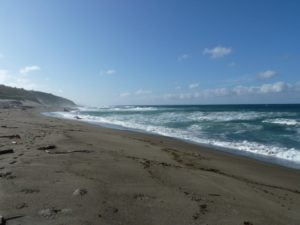Another myth from the village of Volivoli is about a small valley in the sand dunes that they call Nadrio which means “darkness”.
They believe that this certain valley is a doorway to the underworld and that if a falling star falls into the valley, it is a sign that a villager is about to die.
 These stories were garnered from personal interviews by Tessa Miller with villagers especially C. Saimoni, Volivoli Villager.
These stories were garnered from personal interviews by Tessa Miller with villagers especially C. Saimoni, Volivoli Villager.
The villagers of Kulukulu also claim to hear and see spirits of the villagers that were buried alive in the sand dunes.
Legend has it that the Snake God, Degei was angered by the villagers and sent a huge tidal wave that hit the beach and buried the village in sand, killing all its inhabitants.
In Fijian mythology, Degei (pronounced Ndengei), enshrined as a serpent, is the supreme god of Fiji. He is the creator of the (Fijian) world, of fruits, and of men. He judges newly-dead souls after they pass through the doorway to the underworld. A few of these he sends to the Fijian paradise, Burotu. Most others are thrown into a lake, where they will sink to the bottom (Murimuria) to be appropriately rewarded or punished.
Degei is said to have at first moved about freely, but then in the form of a snake to have grown into the earth with his ringed tail. Since then he has become the god of earthquakes, storms, and the seasons. Whenever Ndengei shakes himself fertilising rain will fall, delicious fruits hang on the trees, and the yam fields yield an excellent crop.
But Ndengei is also a god of wrath who declares himself in terrible fashion. He punishes and chastens his people by destroying the crops or by floods; he could indeed easily wipe out mankind from the earth, for since he has lived in the bowels of the earth he has been tormented with so insatiable hunger that he would like to take in and swallow the whole world.[2]
Degei hatched an egg from which the first humans came to Earth. He is prominent in the kalou-vu, the Fijian pantheon.

The Kulukulu have reverence for the dunes and do not make lots of noise when visiting them, especially at night.
The children of nearby villages love listening to the myths and legends of the Sigatoka Sand Dunes.
It is part of their culture and upbringing.
They do not necessarily have to believe all of them, just the fact that they are passed down from generation to generation is enough to keep the legends alive



You must be logged in to post a comment.